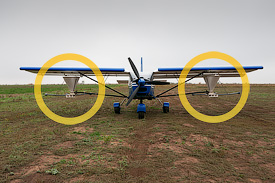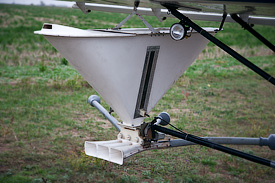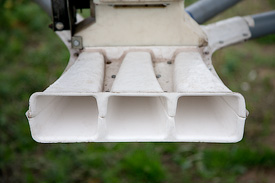Historical Background. In early 2000s the head of the Novator company (then President of the Volgograd Office of the Russian Federation of Ultralight Aviation (OFSLA) Vladimir V. Lygin and the First Deputy President of the Agriculture and Food Committee of the Volgograd Region Administration (being also one of the most experienced agronomist and a specialist on small-seeded crops) Vladimir G. Kubrakov attempted to take on the challenge of seeding mustard in the Volgograd region. The task was to be able to cover large areas in the shortest possible time without buying expensive seeding machinery for small-seeded crops. The solution was to use ultralight aircrafts for aerial seeding. Aerial seeding was not a modern invention: back in 1930s it was applied in the Povolzhje region and Central Asia to seed wheat.
The cooperation of pilots and agronomists resulted in designing and producing aerial seeding equipment that became very efficient on ultralight aircrafts. After extensive experiments, modifications and adjustments, the equipment was submitted to the Institute of Aviation in Agriculture (PANH) for certification under the brand of SA-34 (CA-34). At present, our company is the only supplier of this equipment in the Russian Federation.

An SP-30 aircraft with SA-34 equipment can seed over 400 hectares per day, which is several times more productive than foreign seeding technologies for small-seeded crops and dozens of times more productive than Russian ones. Since 2004, this method has enabled successful seeding of over 60,000 hectares with mustard, camelina, rapeseed and medicago (burclover).
What benefits does aerial seeding offer to agricultural producers? It is clearly speed, first of all, but certainly speed is not the only important factor in agriculture. Aerial seeding can also provide other benefits: the aircraft can do the work when ground machinery cannot operate due to the mud season, whereas wet soil for seeds is a prerequisite of high yield. Thus, frost-seeding of mustard in early spring enables the seeds to take in more moisture. This helps the plant start germinating earlier, establish stronger roots, and thus become better protected from early spring pest – cruciferous flea, while the farmer can save on crop dusting. Or, for example, to get a higher yield of winter camelina sativa, the crop is to be seeded between mid-August and late September so that the plant should have enough time to establish and become strong and prepared for winter. Experts might say that it is not just the time of seeding that is to be accounted for, and they are right. Certainly we cannot control the soil properties and structure, but it is the job of agronomists to know the fields they are working on, to prepare them for crop rotation, to analyze available moisture capacity, and so on. Aerial seeding helps plant the seeds on time and in a proper way, which is an important task too.

So in 2011, for example, early aerial seeding of mustard in the Staraya Poltavka district of the Volgograd Region resulted in the yield of 15,000 kilograms per hectare, and in Klenovka settlement of the Zhirnovsk district (Volgograd region) an agricultural producer harvested over 17,000 kilograms per hectare. Farmers of the Saratov, Penza, Ulyanovsk and Orenburg regions repeatedly invited our company to “rescue” the areas which they had prepared for winter wheat seeding: when ground equipment cannot enter moist fields for weeks in the mud season, aircrafts will easily seed winter camelina sativa between rainfalls.
Aerial seeding is a more complicated type of work in comparison with aerial application of crop protection products and, thus, it is more expensive. Nevertheless, this method is much more economic than using ground machinery – that is why aerial seeding is in all aspects beneficial for customers.
At present, the Russian and European markets experience an increasing demand for oil crops, especially those that are used to produce biofuel, so aerial seeding is becoming a very promising method both for air companies and for farmers.


